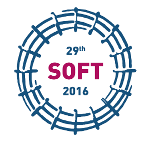Speaker
Hans-Christian Schneider
(Institute for Applied Materials)
Description
Former Investigations clearly had revealed that embrittlement and hardening of RAFM steel after 15 - 70 dpa neutron irradiation damage remarkably can be reduced by short time post-irradiation annealing (PIA) at 550 °C [1, 2].
The purpose of this study is to demonstrate the repeatability of the damage- and recovery-mechanisms to RAFM 7-10% CrWVTa, ODS EUROFER, Boron doped heats of the prior 330 °C Bor 60 reactor (SSC RIAR) irradiations CP1 (6.5 dpa), CP2 (2.5 dpa), and WTZ RUS 01/577 (15 dpa).
Tensile and KLST Charpy-V impact specimens have been investigated in irradiated state after a first annealing (PIA-1), after a subsequent further irradiation up to 4.6 – 5.4 dpa at 330 °C in the Bor 60 reactor, and after a second annealing (PIA-2).
Both, tensile and impact tests clearly indicate that irradiation induced hardening occurs after the second irradiation of intermediately annealed (PIA-1 and thus recovered) material in the same order like after the first irradiation. In addition, a subsequent PIA-2 leads to a complete recovery of the newly applied neutron damage.
This suggests that lifetime of fusion power plant components of RAFM steels substantially could be extended by repeated intermediate annealing treatments and respectively that components could withstand much higher nominal damage dose rates using intermediate annealing.
[1] Gaganidze, E.; Petersen, C.; Materna-Morris, E.; Dethloff, C.; Weiß, O.J.; Aktaa, J.; Povstyanko, A.; Fedoseev, A.; Makarov, O.; Prokhorov, V.: Mechanical properties and TEM examination of RAFM steels irradiated up to 70 dpa in BOR-60, J. Nucl. Mat. 417(2011), p 93 - 98
[2] Sacksteder, I.; Schneider, H.-C.; Materna-Morris, E.: Determining irradiation damage and recovery by instrumented indentation in RAFM steel, J. Nucl. Mat. 417(2011), p 127 - 130
Co-authors
Alexander Fedoseev
(State Scientific Center – Research Institute of Atomic Reactors, Dimitrovgrad, Russian Federation)
Alexander Povstyanko
(State Scientific Center – Research Institute of Atomic Reactors, Dimitrovgrad, Russian Federation)
Claus Petersen
(Ingenieurbüro Petersen, Karlsruhe, Germany)
Hans-Christian Schneider
(Institute for Applied Materials, Karlsruhe Institute of Technology, Karlsruhe, Germany)
Oleg Makarov
(State Scientific Center – Research Institute of Atomic Reactors, Dimitrovgrad, Russian Federation)

